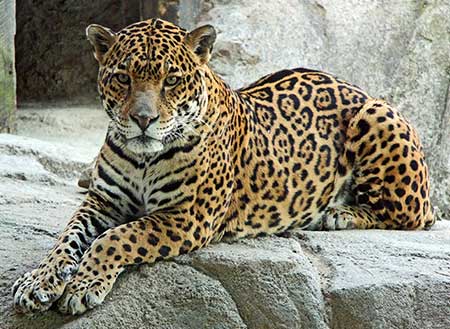Zoo New England mourns death of jaguar
Monday January 5, 2015
 Zoo New England’s Stone Zoo is saddened to report that Pacal, a male jaguar, died on December 31.
Zoo New England’s Stone Zoo is saddened to report that Pacal, a male jaguar, died on December 31.
Pacal, age 16, had been under veterinary care since the diagnosis and removal of a rare tumor from his parathyroid gland in early December. Unfortunately, despite the successful surgery, the effects of the tumor caused lasting changes to his kidneys. Due to his continued declining health, the Zoo staff made the decision to humanely euthanize him for quality of life reasons.
“The veterinary and animal care staff takes extraordinary care of the animals in our collection,” said Dr. Eric Baitchman, Zoo New England Director of Veterinary Services. “We endeavor to practice a high level of medicine, utilizing all diagnostic options at our disposal and involving outside specialists whenever possible, as we did in this case. We were saddened that despite successfully identifying and removing the problem, the effects on Pacal’s body were permanent.”
Through a request by the Jaguar Species Survival Plan (SSP), Pacal arrived at Stone Zoo from Guatemala in 2003 as the result of a collaborative effort involving several zoos accredited by the Association of Zoos and Aquariums (AZA). The Jaguar SSP is a cooperative, inter-zoo program coordinated nationally through AZA. SSPs are designed to maintain genetically diverse and demographically stable captive populations of species. As part of Pacal’s importation, Zoo New England also supported the identification and eventual preservation of key jaguar habitat in Guatemala. While at Stone Zoo, Pacal sired six offspring with his former mate Kanga. His daughter Chessie, born in 2008, still resides at the Zoo.
“Pacal was an incredible ambassador for his species and he will be greatly missed by staff, as well as by the many visitors who came to see him throughout the years,” said John Linehan, Zoo New England President and CEO, who added, “He contributed greatly to the conservation of his species.”
The jaguar is the largest cat and top predator in the western hemisphere. These animals, which are classified as “near threatened” by the International Union for Conservation of Nature (IUCN), are similar in appearance to the leopard but have a shorter tail, a broader head and a more powerful, stocky build. Rosette patterns on the jaguar’s coat, which provide excellent camouflage, are larger than the leopard’s and feature one or more central spots within the rosette. Jaguars, which are elusive and solitary, are native to Central and South America, as well as to the southwestern United States.
Photo courtesy of Fran Mandeville

